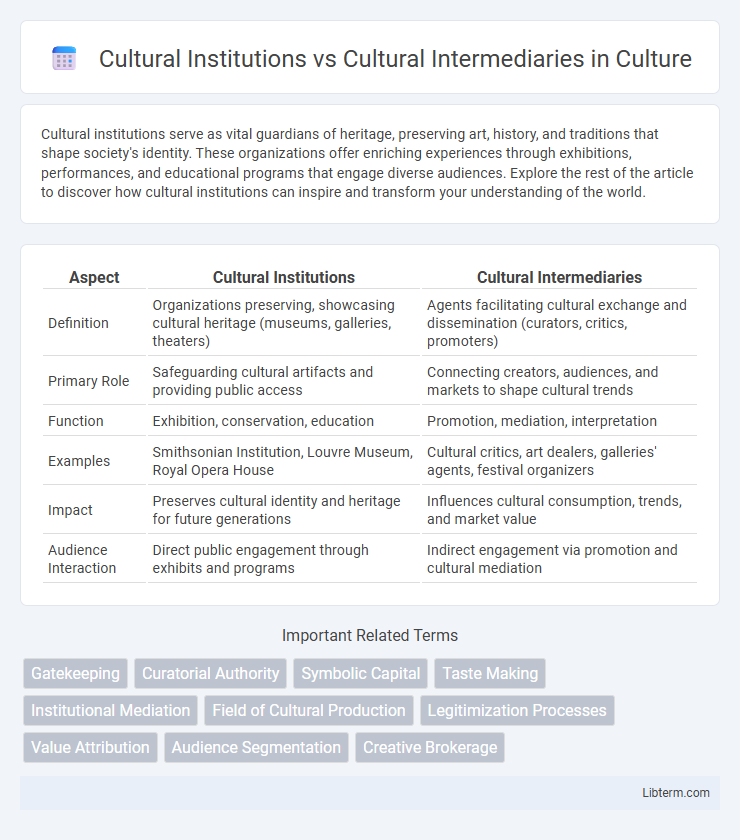Cultural institutions serve as vital guardians of heritage, preserving art, history, and traditions that shape society's identity. These organizations offer enriching experiences through exhibitions, performances, and educational programs that engage diverse audiences. Explore the rest of the article to discover how cultural institutions can inspire and transform your understanding of the world.
Table of Comparison
| Aspect | Cultural Institutions | Cultural Intermediaries |
|---|---|---|
| Definition | Organizations preserving, showcasing cultural heritage (museums, galleries, theaters) | Agents facilitating cultural exchange and dissemination (curators, critics, promoters) |
| Primary Role | Safeguarding cultural artifacts and providing public access | Connecting creators, audiences, and markets to shape cultural trends |
| Function | Exhibition, conservation, education | Promotion, mediation, interpretation |
| Examples | Smithsonian Institution, Louvre Museum, Royal Opera House | Cultural critics, art dealers, galleries' agents, festival organizers |
| Impact | Preserves cultural identity and heritage for future generations | Influences cultural consumption, trends, and market value |
| Audience Interaction | Direct public engagement through exhibits and programs | Indirect engagement via promotion and cultural mediation |
Defining Cultural Institutions
Cultural institutions are established organizations such as museums, galleries, theaters, and libraries that preserve, present, and promote cultural heritage and artistic expressions. These institutions often have formal structures, public or private funding, and are recognized as authoritative custodians of culture, providing access to cultural resources and educational programs. Their role contrasts with cultural intermediaries, who act as agents or facilitators, promoting cultural products and mediating between creators and audiences.
Who Are Cultural Intermediaries?
Cultural intermediaries are individuals or organizations that mediate between cultural producers and consumers, shaping the accessibility and interpretation of cultural products. They include curators, critics, agents, and marketers who influence tastes, trends, and the distribution of art, music, literature, and other cultural commodities. Unlike cultural institutions, which often have formal structures and permanent establishments, cultural intermediaries operate more dynamically within networks to facilitate cultural exchange and consumption.
Historical Evolution of Cultural Mediation
Cultural institutions, established as formal entities like museums and theaters, have played a central role in preserving and presenting cultural heritage since the Enlightenment, emphasizing authoritative transmission of knowledge. Cultural intermediaries emerged later as dynamic agents, such as curators, critics, and community organizers, facilitating interactive cultural exchange and adapting mediation to contemporary social contexts. The historical evolution of cultural mediation reflects a shift from top-down dissemination by institutions to participatory engagement driven by intermediaries.
Core Functions: Institutions vs Intermediaries
Cultural institutions primarily focus on preserving, curating, and exhibiting cultural heritage, serving as custodians of historical artifacts and artistic expressions. Cultural intermediaries act as facilitators who bridge the gap between creators and audiences, promoting, marketing, and interpreting cultural products to enhance accessibility and engagement. While institutions emphasize conservation and scholarly research, intermediaries prioritize mediation, communication, and the dissemination of culture to diverse publics.
Power Dynamics in Cultural Representation
Cultural institutions hold authoritative power by defining and preserving dominant cultural narratives through museums, libraries, and archives, often influencing which histories are legitimized. Cultural intermediaries, such as curators, critics, and media producers, mediate between creators and audiences, shaping cultural perceptions and accessibility through selection and interpretation. Power dynamics in cultural representation are thus contested spaces where gatekeeping roles affect inclusivity, representation diversity, and the amplification or marginalization of cultural voices.
Gatekeeping and Influence on Taste
Cultural institutions such as museums, galleries, and theaters serve as established gatekeepers that legitimize and preserve cultural expressions, enforcing standards of taste through curated exhibitions and official endorsements. Cultural intermediaries, including critics, influencers, and trendsetters, actively shape public taste by mediating between cultural producers and consumers, often promoting emerging or alternative styles that challenge traditional norms. Their influence operates within overlapping networks, where institutional authority meets market-driven dynamics, collectively steering the evolution of cultural preferences and consumption.
Economic Roles in the Cultural Sector
Cultural institutions, such as museums and theaters, serve as primary producers and preservers of cultural goods, often funded by public or private subsidies to maintain cultural heritage and promote public access. Cultural intermediaries, including critics, curators, and marketers, play a crucial economic role by shaping consumer demand, influencing cultural consumption patterns, and enhancing market visibility for cultural products. Together, these entities drive the economic dynamics of the cultural sector by balancing the creation, distribution, and commercial success of cultural content.
Digital Transformation and Changing Roles
Cultural institutions are traditional entities like museums and theaters that preserve and showcase cultural heritage, while cultural intermediaries act as facilitators connecting creators with audiences through digital platforms. Digital transformation has shifted cultural intermediaries into pivotal roles by leveraging technology to enhance accessibility, engagement, and personalized experiences beyond the physical confines of cultural institutions. This evolution redefines audience interaction, with cultural intermediaries adopting data-driven strategies and virtual tools, enabling cultural institutions to expand their reach and adapt to the rapidly changing digital landscape.
Collaboration and Conflict in the Cultural Ecosystem
Cultural institutions, such as museums and libraries, serve as custodians and promoters of heritage, while cultural intermediaries, including curators and critics, act as facilitators translating cultural content to diverse audiences. Collaboration between these entities enhances the cultural ecosystem by fostering innovation and expanding accessibility, yet conflicts arise over control of narratives, resource allocation, and representation rights. Understanding these dynamics is crucial for developing cooperative strategies that balance institutional authority with intermediary influence, ensuring a vibrant and inclusive cultural landscape.
Future Trends in Cultural Mediation
Cultural institutions will increasingly integrate digital technologies to enhance audience engagement and accessibility, fostering immersive experiences through virtual reality and augmented reality. Cultural intermediaries are poised to leverage data analytics and AI-driven personalization to curate tailored cultural content, bridging the gap between creators and diverse audiences. Emerging trends emphasize collaborative networks and participatory models, enabling more dynamic cultural mediation that responds to evolving social and technological landscapes.
Cultural Institutions Infographic

 libterm.com
libterm.com